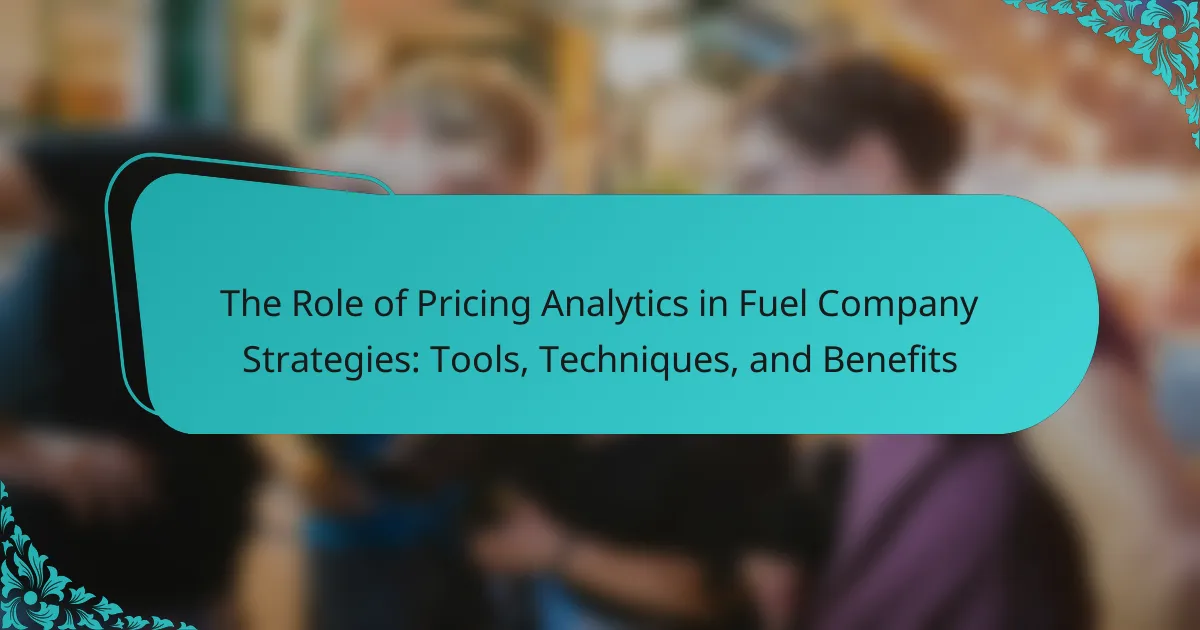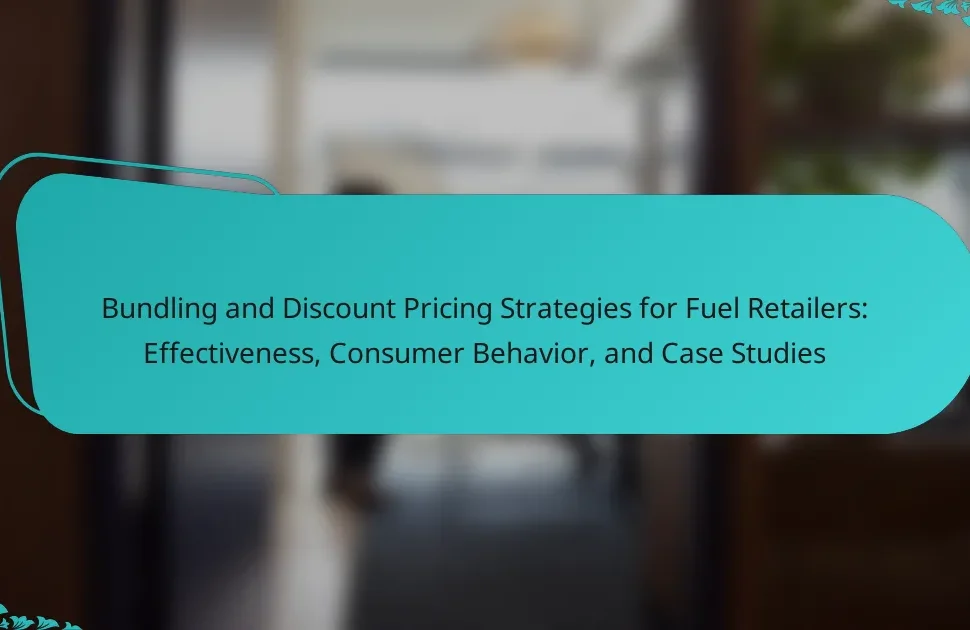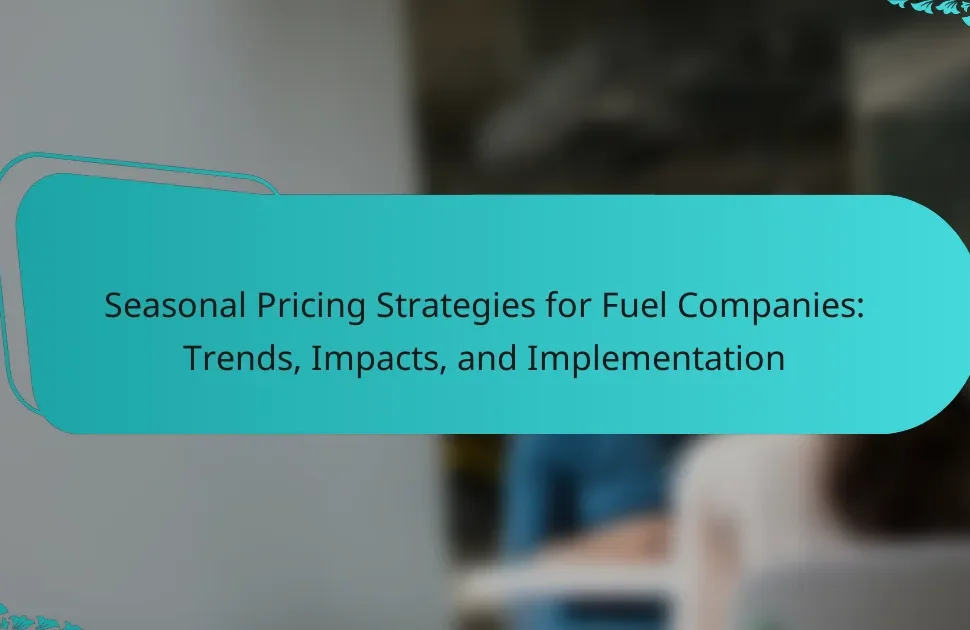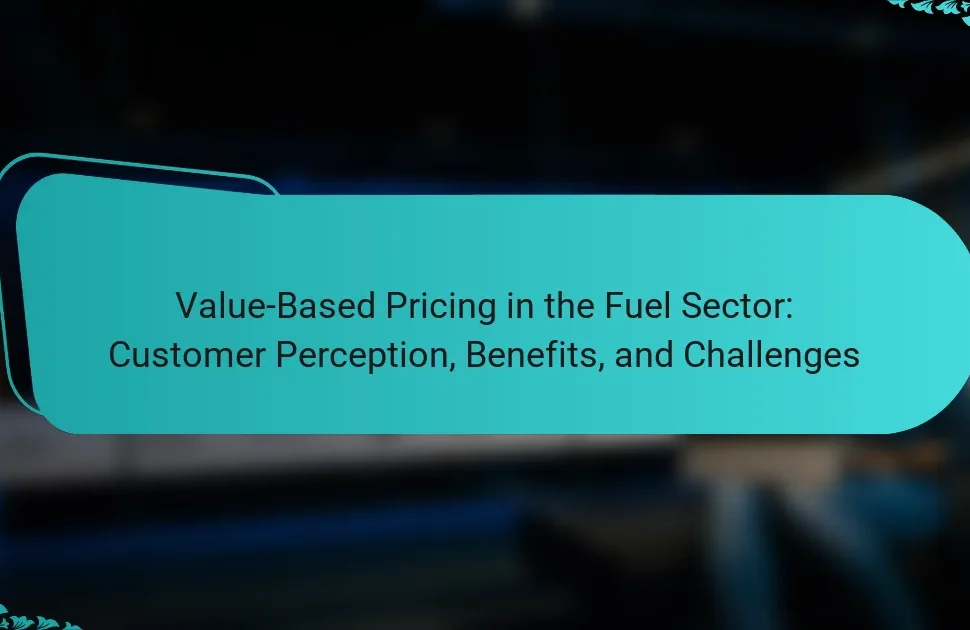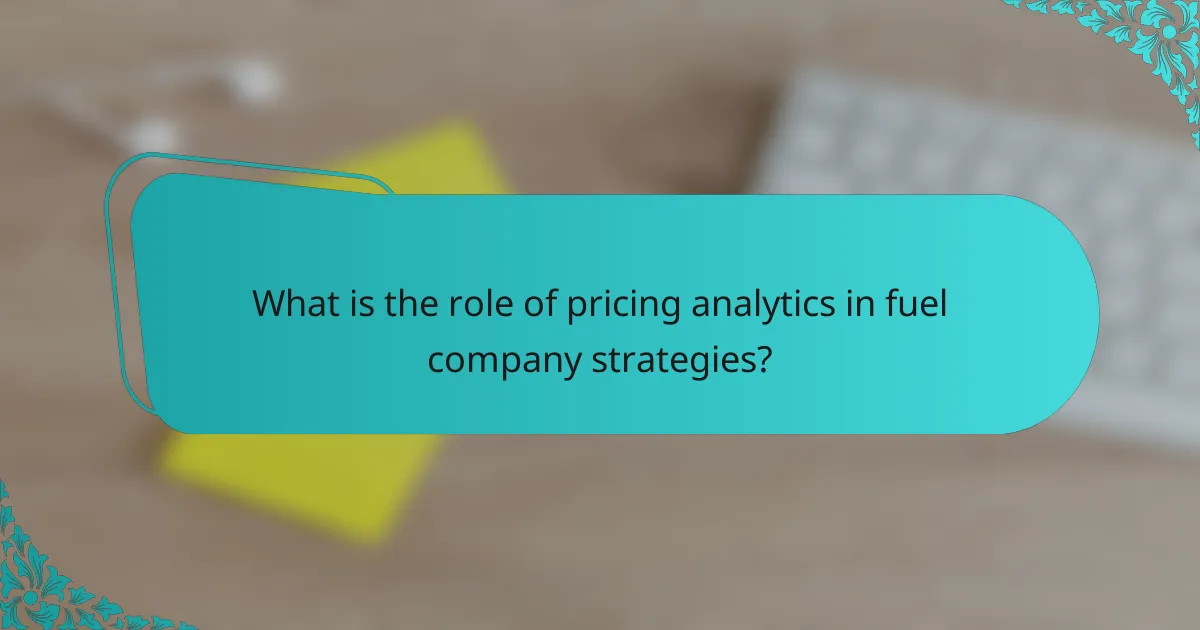
What is the role of pricing analytics in fuel company strategies?
Pricing analytics plays a crucial role in fuel company strategies. It helps companies optimize pricing by analyzing market trends and consumer behavior. This analysis enables fuel companies to set competitive prices that maximize profit margins. Pricing analytics also aids in forecasting demand, allowing companies to adjust prices dynamically. This responsiveness can lead to increased market share and customer loyalty. Additionally, data-driven insights from pricing analytics can identify cost-saving opportunities. Companies can use these insights to enhance operational efficiency. Overall, pricing analytics is integral to strategic decision-making in the fuel industry.
How does pricing analytics impact decision-making in fuel companies?
Pricing analytics significantly influences decision-making in fuel companies by providing data-driven insights. These insights help companies optimize pricing strategies in response to market fluctuations. Fuel companies utilize historical data to forecast demand and adjust prices accordingly. This proactive approach can enhance profitability and market competitiveness.
For instance, a study by McKinsey & Company found that companies using advanced pricing analytics improved their margins by 2-5%. Additionally, pricing analytics enables fuel companies to identify customer segments willing to pay different prices. This segmentation allows for targeted promotions and pricing strategies.
Moreover, real-time analytics help companies react swiftly to changes in supply chain costs or competitor pricing. By integrating pricing analytics into their decision-making processes, fuel companies can make informed choices that align with market dynamics. This ultimately leads to improved financial performance and customer satisfaction.
What are the key metrics used in pricing analytics for fuel companies?
Key metrics used in pricing analytics for fuel companies include price elasticity, competitor pricing, and market demand. Price elasticity measures how sensitive consumers are to price changes. Competitor pricing involves analyzing prices set by rival fuel companies. Market demand assesses the volume of fuel required by consumers at various price points. Other important metrics include gross margin, which reflects profitability per unit sold, and inventory turnover, indicating how quickly fuel stock is sold. These metrics are critical for optimizing pricing strategies and maximizing revenue in the competitive fuel market.
How do fuel companies gather data for pricing analytics?
Fuel companies gather data for pricing analytics through multiple methods. They collect market data from various sources, including competitor pricing, supply chain costs, and consumer demand trends. Companies utilize advanced analytics tools to process this data effectively. They also monitor global oil prices and geopolitical events that may impact pricing. Additionally, fuel companies analyze historical sales data to understand pricing patterns. Surveys and customer feedback provide insights into consumer preferences. Real-time data collection systems track fuel inventory levels and sales transactions. These combined efforts enable fuel companies to make informed pricing decisions.
Why is pricing analytics essential for fuel companies?
Pricing analytics is essential for fuel companies because it enables data-driven decision-making. Accurate pricing strategies help maximize profit margins. Fuel companies face fluctuating market conditions that affect pricing. Analytics provide insights into competitor pricing and market trends. This information allows companies to adjust prices dynamically. Effective pricing strategies can lead to increased customer loyalty. Additionally, pricing analytics can identify optimal pricing models. Companies can leverage this data to enhance overall business performance.
What competitive advantages does pricing analytics provide?
Pricing analytics provides fuel companies with the ability to optimize pricing strategies based on market demand and competition. It enables precise adjustments to pricing in real-time, enhancing revenue management. Companies can identify price elasticity, allowing for informed decisions on pricing changes. This leads to improved profit margins by aligning prices with consumer willingness to pay.
Additionally, pricing analytics helps in segmenting customers based on their purchasing behavior. This targeted approach allows for personalized pricing strategies, increasing customer loyalty. By leveraging historical sales data, companies can forecast future trends accurately. This predictive capability aids in inventory management and reduces the risk of stockouts or overstock situations.
Moreover, effective pricing analytics fosters competitive positioning in the market. Companies that utilize data-driven insights can react swiftly to competitor pricing strategies. This agility can lead to capturing greater market share. Research from McKinsey shows that companies employing advanced pricing analytics can increase revenue by 2-7%.
How does pricing analytics influence customer behavior in the fuel industry?
Pricing analytics significantly influences customer behavior in the fuel industry by optimizing pricing strategies. It allows companies to analyze market trends and consumer preferences. This analysis helps fuel companies set competitive prices that attract customers. For instance, dynamic pricing models adjust prices based on demand fluctuations. According to a study by McKinsey, companies using pricing analytics can increase revenue by 2-7%. Furthermore, personalized pricing strategies based on customer data enhance customer loyalty. Customers are more likely to respond positively to prices that reflect their buying patterns. Overall, pricing analytics drives informed decision-making, leading to improved customer engagement and satisfaction.
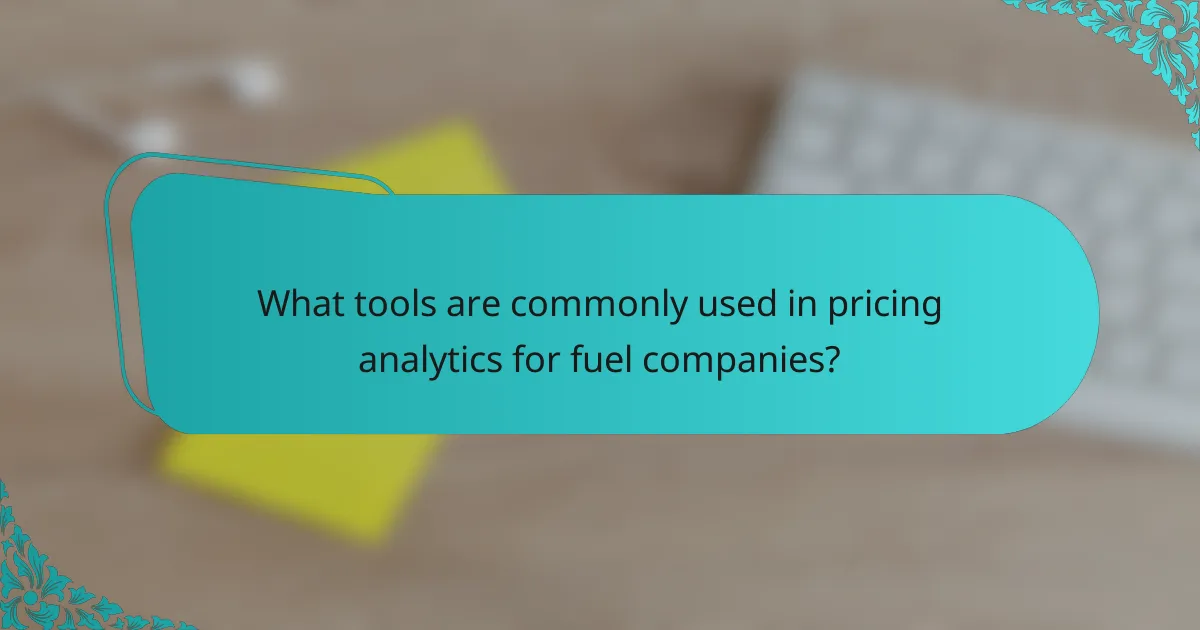
What tools are commonly used in pricing analytics for fuel companies?
Common tools used in pricing analytics for fuel companies include advanced analytics software, pricing optimization tools, and data visualization platforms. Advanced analytics software, such as SAS and IBM SPSS, helps analyze large datasets to identify pricing trends. Pricing optimization tools like Pricefx and Zilliant enable companies to set competitive prices based on market conditions. Data visualization platforms, such as Tableau and Power BI, allow for effective presentation of pricing data. These tools enhance decision-making by providing insights into market dynamics and consumer behavior.
How do software solutions enhance pricing analytics capabilities?
Software solutions enhance pricing analytics capabilities by providing advanced data processing and analysis tools. They enable companies to collect large volumes of pricing data from various sources. This data can be analyzed in real-time for more accurate pricing strategies. Software solutions also offer predictive analytics features. These features help forecast market trends and consumer behavior. Additionally, they facilitate segmentation of customer data for targeted pricing. Automation of pricing adjustments is another key benefit. This reduces manual errors and increases efficiency. According to a study by McKinsey, companies using advanced pricing analytics can see profit increases of 2-7%.
What are the leading pricing analytics tools for fuel companies?
The leading pricing analytics tools for fuel companies include Pricefx, FuelQuest, and SAP Pricing. Pricefx offers cloud-based pricing solutions tailored for fuel pricing strategies. FuelQuest specializes in fuel supply chain management and pricing analytics. SAP Pricing integrates with broader enterprise resource planning systems to enhance fuel pricing accuracy. These tools help fuel companies optimize pricing strategies and improve profitability.
How do these tools integrate with existing systems in fuel companies?
Pricing analytics tools integrate with existing systems in fuel companies through data synchronization and API connections. These tools pull data from various sources like inventory management, sales systems, and market analysis platforms. They analyze pricing trends and customer behavior to optimize fuel pricing strategies. Integration often involves cloud-based solutions that ensure real-time data updates. This enhances decision-making processes by providing accurate pricing insights. Research shows that companies utilizing integrated analytics see a 10-15% increase in pricing efficiency. Additionally, seamless integration minimizes operational disruptions and promotes data-driven strategies.
What role does data visualization play in pricing analytics?
Data visualization plays a crucial role in pricing analytics by transforming complex data into understandable visual formats. It enables fuel companies to identify pricing trends and patterns quickly. With visual representations, stakeholders can easily interpret data insights. This facilitates informed decision-making regarding pricing strategies. Effective data visualization helps in highlighting key performance indicators. It also supports real-time monitoring of market conditions. According to a study by Tableau, 70% of business leaders believe data visualization aids in better decision-making. Thus, data visualization enhances the overall effectiveness of pricing analytics in fuel company strategies.
How can fuel companies effectively use dashboards for pricing strategies?
Fuel companies can effectively use dashboards for pricing strategies by integrating real-time data analytics. Dashboards provide visual representations of market trends, competitor pricing, and consumer demand. This information allows companies to make informed pricing decisions quickly. For instance, a dashboard can display fluctuations in crude oil prices, enabling timely adjustments to retail prices. Additionally, dashboards can track historical sales data to identify pricing patterns and optimize future pricing strategies. According to a report by McKinsey, companies leveraging data analytics can increase their pricing accuracy by up to 15%. This demonstrates the impact of effective dashboard utilization on pricing strategies in the fuel industry.
What are the best practices for presenting pricing analytics data?
Use clear visualizations to present pricing analytics data. Charts and graphs enhance understanding. Ensure data is accurate and sourced from reliable platforms. Use consistent formatting for easy comparison. Highlight key insights to draw attention to important trends. Provide context for the data by including benchmarks or historical comparisons. Tailor the presentation to the audience’s expertise level. Use storytelling techniques to make data relatable and engaging.
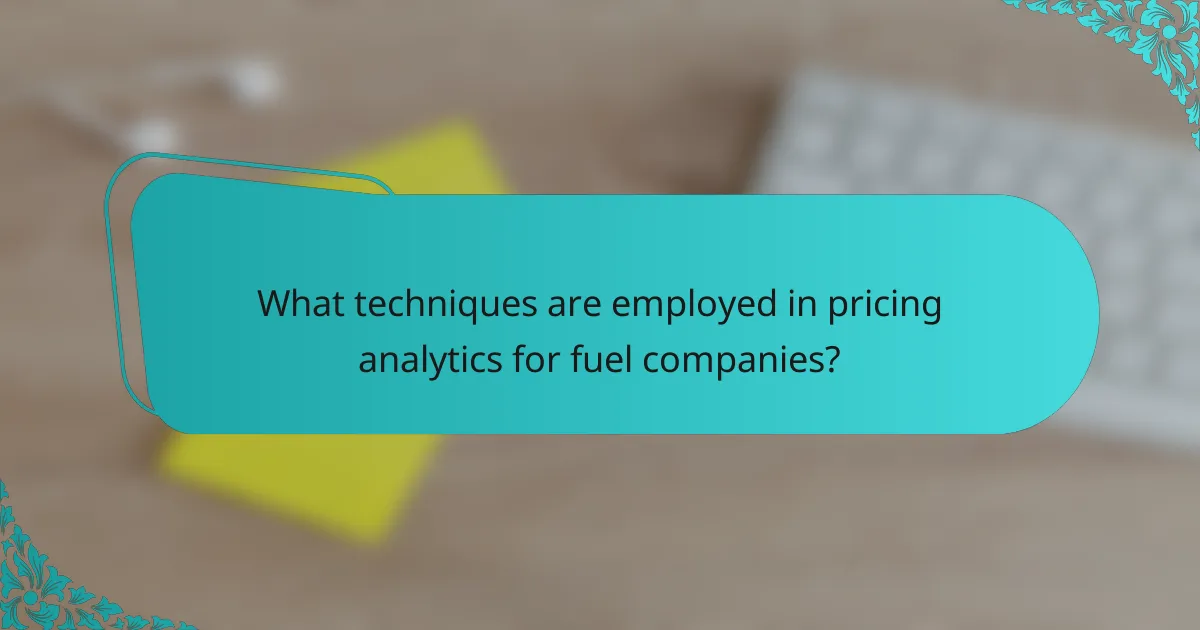
What techniques are employed in pricing analytics for fuel companies?
Fuel companies employ several techniques in pricing analytics. These techniques include demand forecasting, competitive analysis, and cost-plus pricing. Demand forecasting uses historical data to predict future fuel consumption patterns. Competitive analysis examines pricing strategies of rival companies to determine optimal pricing. Cost-plus pricing calculates prices by adding a markup to the cost of producing fuel.
Additionally, fuel companies utilize price elasticity analysis. This technique assesses how changes in price affect consumer demand. Advanced analytics and machine learning algorithms are also applied to optimize pricing strategies. These methods enable companies to adapt quickly to market changes.
Recent studies show that effective pricing analytics can lead to increased profitability. For instance, companies using these techniques often experience a 5-10% increase in revenue.
How do predictive analytics shape pricing strategies in the fuel industry?
Predictive analytics shape pricing strategies in the fuel industry by analyzing historical data and forecasting future trends. These analytics utilize algorithms to assess variables such as supply, demand, and market conditions. Fuel companies can optimize pricing by understanding consumer behavior patterns. For instance, predictive models may indicate peak demand periods, allowing companies to adjust prices accordingly. Historical data shows that companies using predictive analytics can increase revenue by 5-10%. This approach also helps mitigate risks related to price volatility. By leveraging predictive analytics, fuel companies can enhance their competitive edge in the market.
What algorithms are most effective for pricing optimization?
Machine learning algorithms are most effective for pricing optimization. These algorithms analyze large datasets to identify pricing patterns and consumer behavior. Regression analysis is commonly used to predict price elasticity. Decision trees help in segmenting customers based on willingness to pay. Neural networks can model complex relationships between variables. Reinforcement learning optimizes prices dynamically based on real-time data. Historical data shows that companies using these algorithms achieve higher revenue growth. A study by McKinsey found that advanced analytics can improve pricing effectiveness by 2-7%.
How do fuel companies use historical data in pricing models?
Fuel companies utilize historical data to inform their pricing models. They analyze past fuel prices, demand patterns, and external factors such as geopolitical events. This data helps in forecasting future price trends. Historical data also allows companies to understand seasonal fluctuations in fuel consumption. By examining previous sales data, companies can optimize their pricing strategies. They adjust prices based on anticipated demand and market conditions. Additionally, historical data aids in competitive analysis, allowing companies to position their prices effectively. This approach enhances profitability and market share.
What are the challenges faced when implementing pricing analytics?
The challenges faced when implementing pricing analytics include data integration, accuracy of data, and organizational resistance. Data integration issues arise when consolidating information from various sources. Inconsistent data formats can complicate analysis. Accuracy of data is critical; incorrect data can lead to poor pricing decisions. Organizational resistance may stem from a lack of understanding or fear of change. Employees may be hesitant to adopt new technologies. Additionally, skill gaps in analytics tools can hinder effective implementation. Companies may struggle to find qualified personnel to interpret complex data. These challenges can significantly impact the effectiveness of pricing strategies in fuel companies.
How can fuel companies overcome data quality issues in pricing analytics?
Fuel companies can overcome data quality issues in pricing analytics by implementing robust data validation processes. Regular audits of data sources help ensure accuracy and consistency. Utilizing advanced data cleansing tools can eliminate errors and standardize data formats. Training staff on data management best practices enhances awareness of quality control. Establishing clear data governance policies promotes accountability in data handling. Collaborating with technology partners can provide access to better data integration solutions. Monitoring data quality metrics regularly allows for proactive identification of issues. These strategies collectively improve the reliability of pricing analytics, leading to more informed decision-making.
What organizational changes are necessary for successful pricing analytics adoption?
Successful pricing analytics adoption requires organizational changes that enhance data-driven decision-making. First, companies must establish a culture that prioritizes data analytics. This involves training staff on analytical tools and techniques. Second, organizations need to restructure teams to include data analysts alongside pricing strategists. This collaboration fosters better insights and strategies. Third, integrating pricing analytics into existing workflows is essential. This ensures that data is consistently used in pricing decisions. Finally, leadership must support these changes by allocating resources and setting clear goals for analytics outcomes. These adjustments lead to improved pricing strategies and overall business performance.
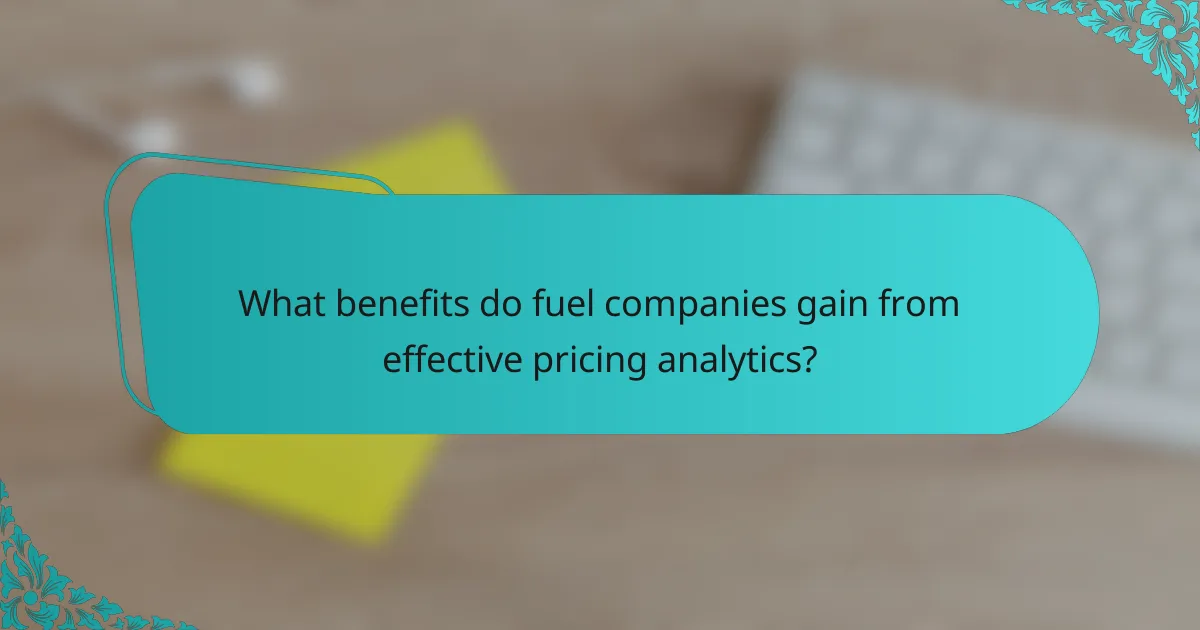
What benefits do fuel companies gain from effective pricing analytics?
Fuel companies gain several benefits from effective pricing analytics. These benefits include enhanced decision-making capabilities. Pricing analytics allows companies to analyze market trends and consumer behavior. This analysis leads to optimized pricing strategies. Companies can adjust prices based on demand fluctuations. Effective pricing analytics also improves profit margins. By identifying the optimal price point, companies maximize revenue. Furthermore, it aids in competitive analysis. Fuel companies can monitor competitors’ pricing and adapt accordingly. Overall, effective pricing analytics supports strategic planning and operational efficiency.
How does pricing analytics improve profitability for fuel companies?
Pricing analytics enhances profitability for fuel companies by optimizing pricing strategies. It allows companies to analyze market trends and consumer behavior. This analysis helps in setting competitive prices that attract customers while maximizing margins. Fuel companies can forecast demand more accurately using historical data. Improved demand forecasting reduces inventory costs and minimizes stockouts. Additionally, pricing analytics identifies price elasticity, enabling companies to adjust prices effectively. Research shows that companies using pricing analytics can increase profits by up to 20%. This data-driven approach leads to informed decision-making and improved financial performance.
What impact does pricing analytics have on market share?
Pricing analytics positively impacts market share by enabling companies to make data-driven pricing decisions. These analytics help identify optimal price points based on consumer behavior and competitor pricing. By accurately assessing demand elasticity, companies can adjust prices to maximize sales and revenue. This strategic pricing can lead to increased competitiveness in the market. For example, a study by McKinsey & Company found that companies using pricing analytics improved their market share by up to 10%. Effective pricing strategies derived from analytics can attract price-sensitive customers and enhance brand loyalty. Overall, leveraging pricing analytics is crucial for companies aiming to expand their market presence.
How can fuel companies enhance customer satisfaction through pricing strategies?
Fuel companies can enhance customer satisfaction through strategic pricing by implementing competitive pricing models. These models ensure that fuel prices are aligned with market rates. Regularly analyzing competitor pricing allows companies to adjust their prices accordingly. Offering loyalty programs and discounts can further increase customer retention. Transparent pricing practices build trust and encourage repeat business. Additionally, dynamic pricing based on demand can optimize sales during peak times. Research shows that companies using data analytics for pricing can improve customer satisfaction by 20%. This approach allows for better inventory management and price adjustments that meet consumer expectations.
What are the best practices for leveraging pricing analytics in fuel companies?
The best practices for leveraging pricing analytics in fuel companies include utilizing real-time data analysis, implementing competitive pricing strategies, and optimizing pricing models based on demand forecasts. Real-time data analysis helps fuel companies adjust prices dynamically according to market conditions. Competitive pricing strategies allow companies to stay ahead of market trends and competitor pricing. Optimizing pricing models based on demand forecasts ensures that pricing reflects consumer behavior and market fluctuations. Additionally, integrating advanced analytics tools can enhance decision-making processes. These practices lead to improved profitability and market share in the fuel industry.
How can fuel companies continuously improve their pricing strategies using analytics?
Fuel companies can continuously improve their pricing strategies using analytics by leveraging data-driven insights. Analytics helps identify market trends and customer behavior. By analyzing historical sales data, companies can forecast demand more accurately. This allows for dynamic pricing adjustments based on real-time market conditions. Predictive analytics can also highlight price elasticity, informing companies how changes in price may affect sales volume. Additionally, competitive analysis tools enable fuel companies to monitor competitor pricing strategies. This information can lead to strategic pricing decisions that enhance market positioning. According to a study by McKinsey, companies that use advanced analytics for pricing can increase profits by 2-5%.
What common mistakes should fuel companies avoid in pricing analytics?
Fuel companies should avoid relying on outdated data in pricing analytics. Using historical data without considering current market conditions can lead to inaccurate pricing strategies. Another mistake is failing to segment customers effectively. Homogenizing customer data can overlook unique pricing sensitivities among different groups. Additionally, not incorporating competitor pricing into analysis can result in missed opportunities. Ignoring the impact of external factors, such as regulatory changes, can also skew pricing decisions. Lastly, neglecting to continuously monitor and adjust pricing strategies can hinder competitiveness. Consistent evaluation and adaptation are crucial for effective pricing analytics.
The main entity of the article is pricing analytics within fuel company strategies. The article explores the critical role of pricing analytics in optimizing pricing, enhancing decision-making, and improving profitability for fuel companies. It covers key metrics used in pricing analytics, methods for data gathering, and the tools that facilitate effective pricing strategies. Additionally, the article discusses the impact of pricing analytics on market share and customer satisfaction, as well as the best practices and common challenges associated with its implementation in the fuel industry.
